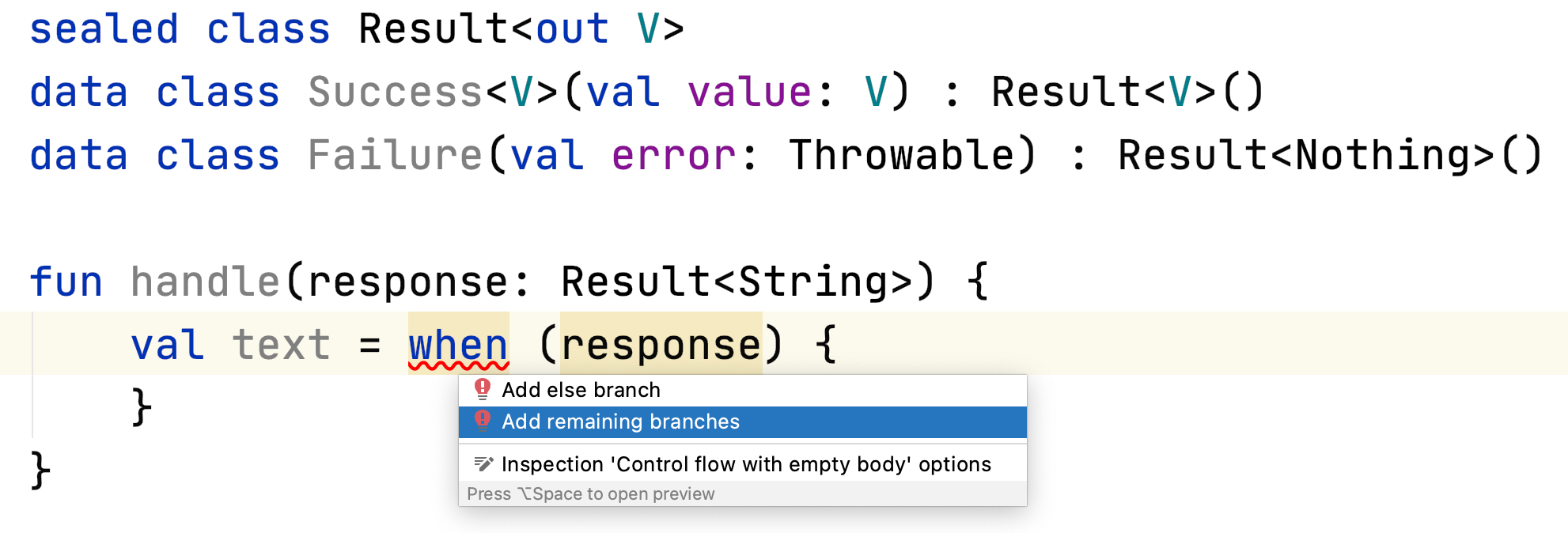
Effective Kotlin Item 39: Use sealed classes and interfaces to express restricted hierarchies
This is a chapter from the book Effective Kotlin. You can find it on LeanPub or Amazon.
Sealed classes and interfaces represent restricted hierarchies, which means hierarchies with a concrete set of classes that is known in advance. Great examples are BinaryTree (which is either Leaf or Node) and Either (which is either Left or Right). Such classes or interfaces have a concrete subset of children that will never change.
sealed interface BinaryTree class Leaf(val value: Any?) : BinaryTree class Node(val left: Tree, val right: Tree) : BinaryTree sealed interface Either<out L, out R> class Left<L>(val value: L) : Either<L, Nothing> class Right<R>(val value: R) : Either<Nothing, R>
Sealed interfaces were introduced in Kotlin 1.5. Before that version, we had to use sealed classes whose subclasses had to be defined in the same file.
Sealed classes are also used to represent hierarchies that might change in the future but are considered final now, such as a set of operations we support, or the messages an actor accepts.
sealed class ValueChange<out T> object Keep: ValueChange<Nothing>() object SetDefault: ValueChange<Nothing>() object SetEmpty: ValueChange<Nothing>() class Set<out T>(val value: T): ValueChange<T>() sealed class ManagerMessage class CodeProduced(val code: String): ManagerMessage() object ProductionStopped: ManagerMessage() sealed interface AdView object FacebookAd: AdView object GoogleAd: AdView class OwnAd(val text: String, val imgUrl: String): AdView
Notice that when a class does not hold any data, we use an object declaration. This is an optimization as it means we have one instance for all usages. Both creation and comparison are easier.
One might say that a sealed class or interface is a Kotlin way of expressing union types (sum types or coproducts) — a set of alternatives. For instance, Either is either Left or Right, but it is never both.
Sealed classes are abstract classes, but because of their characteristics they also have some additional restrictions on their subclasses:
- they need to be defined in the same package and module where the sealed class is defined,
- they can't be local or anonymous objects.
This means that when you use the sealed modifier, you control which subclasses a class or interface has. The clients of your library or module cannot add their own. No one can quietly add a local class or object expression that extends this class. The hierarchy of subclasses is restricted.
Sealed classes and when expressions
Using when as an expression forces us to return a value for every branch. In most cases, the only way to cover all possibilities is to specify an else clause. The power of having a finite type as an argument makes it possible to have an exhaustive when with a branch for every possible value, which with sealed classes means is checks for all possible subtypes. Also, IntelliJ automatically suggests adding the remaining branches. These two make sealed classes very convenient to check for all possible types.

sealed class Response<out R> class Success<R>(val value: R): Response<R>() class Failure(val error: Throwable): Response<Nothing>() fun handle(response: Response<String>) { val text = when (response) { is Success -> "Success with ${response.value}" is Failure -> "Error" // else is not needed here } print(text) }
Notice that when the else clause is not used, and when we add another subclass of this sealed class, the usage needs to be adjusted by including this new type. This is convenient in local code as it forces us to handle this new class in all exhaustive when expressions (so, typically in most cases where we need to). The inconvenient part is that when this sealed class is part of the public API of some library or shared module, adding a subtype is a breaking change.
Summary
Sealed classes and interfaces should be used to represent restricted hierarchies. They make it easier to handle each possible value and, as a result, to add new methods using extension functions. Abstract classes leave space for new classes to join this hierarchy. If we want to control what the subclasses of a class are, we should use the sealed modifier. We use abstract mainly when we design for inheritance.